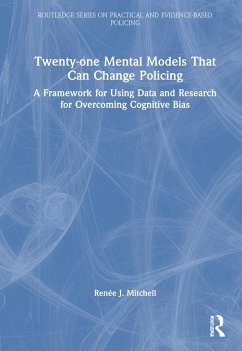Renée J Mitchell
Twenty-One Mental Models That Can Change Policing
A Framework for Using Data and Research for Overcoming Cognitive Bias
Renée J Mitchell
Twenty-One Mental Models That Can Change Policing
A Framework for Using Data and Research for Overcoming Cognitive Bias
- Gebundenes Buch
- Merkliste
- Auf die Merkliste
- Bewerten Bewerten
- Teilen
- Produkt teilen
- Produkterinnerung
- Produkterinnerung
This book goes beyond other police leadership books to teach practitioners how to think about policing in a structured way that synthesizes criminological theory, statistics, research design, applied research, and what works and what doesn't in policing into Mental Models.
Andere Kunden interessierten sich auch für
![Police Administration Police Administration]() Gary W. CordnerPolice Administration286,99 €
Gary W. CordnerPolice Administration286,99 €![Effective Police Supervision Study Guide Effective Police Supervision Study Guide]() Chris Rush BurkeyEffective Police Supervision Study Guide52,99 €
Chris Rush BurkeyEffective Police Supervision Study Guide52,99 €![Women and the Criminal Justice System Women and the Criminal Justice System]() Katherine Stuart van WormerWomen and the Criminal Justice System285,99 €
Katherine Stuart van WormerWomen and the Criminal Justice System285,99 €![Stop and Search and Police Legitimacy Stop and Search and Police Legitimacy]() Ben BradfordStop and Search and Police Legitimacy195,99 €
Ben BradfordStop and Search and Police Legitimacy195,99 €![Integrated Offender Management and the Policing of Prolific Offenders Integrated Offender Management and the Policing of Prolific Offenders]() Frederick CramIntegrated Offender Management and the Policing of Prolific Offenders185,99 €
Frederick CramIntegrated Offender Management and the Policing of Prolific Offenders185,99 €![Policing European Metropolises Policing European Metropolises]() Policing European Metropolises199,99 €
Policing European Metropolises199,99 €![Advances in Evidence-Based Policing Advances in Evidence-Based Policing]() Advances in Evidence-Based Policing188,99 €
Advances in Evidence-Based Policing188,99 €-
-
-
This book goes beyond other police leadership books to teach practitioners how to think about policing in a structured way that synthesizes criminological theory, statistics, research design, applied research, and what works and what doesn't in policing into Mental Models.
Hinweis: Dieser Artikel kann nur an eine deutsche Lieferadresse ausgeliefert werden.
Hinweis: Dieser Artikel kann nur an eine deutsche Lieferadresse ausgeliefert werden.
Produktdetails
- Produktdetails
- Verlag: Taylor & Francis
- Seitenzahl: 210
- Erscheinungstermin: 16. September 2021
- Englisch
- Abmessung: 254mm x 178mm x 14mm
- Gewicht: 612g
- ISBN-13: 9780367481476
- ISBN-10: 0367481472
- Artikelnr.: 62227720
- Herstellerkennzeichnung
- Libri GmbH
- Europaallee 1
- 36244 Bad Hersfeld
- gpsr@libri.de
- Verlag: Taylor & Francis
- Seitenzahl: 210
- Erscheinungstermin: 16. September 2021
- Englisch
- Abmessung: 254mm x 178mm x 14mm
- Gewicht: 612g
- ISBN-13: 9780367481476
- ISBN-10: 0367481472
- Artikelnr.: 62227720
- Herstellerkennzeichnung
- Libri GmbH
- Europaallee 1
- 36244 Bad Hersfeld
- gpsr@libri.de
Renée J. Mitchell served in the Sacramento Police Department for twenty-two years and is currently a Senior Police Researcher with RTI International. She holds a B.S. in Psychology, a M.A. in Counseling Psychology, a M.B.A., a J.D., and a Ph.D. in Criminology from the University of Cambridge. She has taught and lectured internationally on evidence-based policing and is best known for being the first policing pracademic to run a randomized controlled trial. She was a Fulbright Police Research Fellow and is the co-founder and executive committee member of the American Society of Evidence-Based Policing. She has two TEDx talks, "Research Not Protests" and "Policing Needs to Change: Trust me I'm a Cop," where she advocates for evidence-based policing. She has published her research in the Journal of Experimental Criminology, Justice Quarterly, and the Cambridge Journal of Evidence-Based Policing. Her books include Evidence Based Policing: An introduction and Implementing Evidence-Based Research: A How-to Guide for Police Organizations.
Introduction: What is a Mental Model and How Does It Help Policing
PART I: How We Think
Mental Model #1: System 1 and 2
Mental Model #2: Cognitive Bias
Mental Model #3: First Principles Thinking
The Mental Models in Practice I: Mental Models 1-3
Part II: How We Think About Math
Mental Model #4: False Linear Thinking
Mental Model #5: Binary Percent Changes
Mental Model #6: Second Order Thinking
The Mental Models in Practice II: Mental Models 4-6
PART III: How Things Concentrate
Mental Model #7: Pareto Principle
Mental Model #8: The Law of Crime concentration
Mental Model #9: Felonious Few
The Mental Models in Practice III: Mental Models 7-9
PART IV: How Things Vary
Mental Model #10: Distributions
Mental Model #11: Law of Large numbers
Mental Model #12: Regression to the Mean
The Mental Models in Practice IV: Mental Models 10-12
PART V: How to Determine Causality
Mental Model #13: Correlation is not Causation
Mental Model #14: Causal Inference
Mental Model #15: Bayesian (Probabilistic) Reasoning
The Mental Models in Practice V: Mental Models 13-15
Part VI: How to Think Scientifically
Mental Model #16: Peer Review Your Perspectives
Mental Model #17: The Scientific Method
Mental Model #18: Evidence-based Practices
The Mental Models in Practice VI: Mental Models 16-18
PART VII: How to Make Decisions
Mental Model #19: Targeting, Testing, and Tracking
Mental Model #20: Harm Indexes
Mental Model #21: Decision-making Models
The Mental Models in Practice VII: Mental Models 19-21
PART VIII: How to Apply it All
Conclusion: How the Twenty-one Mental Models Can Improve Policing and Reduce Cognitive Bias
Mental Model Method: How it all Fits Together Mental Models 1-21
Notes
PART I: How We Think
Mental Model #1: System 1 and 2
Mental Model #2: Cognitive Bias
Mental Model #3: First Principles Thinking
The Mental Models in Practice I: Mental Models 1-3
Part II: How We Think About Math
Mental Model #4: False Linear Thinking
Mental Model #5: Binary Percent Changes
Mental Model #6: Second Order Thinking
The Mental Models in Practice II: Mental Models 4-6
PART III: How Things Concentrate
Mental Model #7: Pareto Principle
Mental Model #8: The Law of Crime concentration
Mental Model #9: Felonious Few
The Mental Models in Practice III: Mental Models 7-9
PART IV: How Things Vary
Mental Model #10: Distributions
Mental Model #11: Law of Large numbers
Mental Model #12: Regression to the Mean
The Mental Models in Practice IV: Mental Models 10-12
PART V: How to Determine Causality
Mental Model #13: Correlation is not Causation
Mental Model #14: Causal Inference
Mental Model #15: Bayesian (Probabilistic) Reasoning
The Mental Models in Practice V: Mental Models 13-15
Part VI: How to Think Scientifically
Mental Model #16: Peer Review Your Perspectives
Mental Model #17: The Scientific Method
Mental Model #18: Evidence-based Practices
The Mental Models in Practice VI: Mental Models 16-18
PART VII: How to Make Decisions
Mental Model #19: Targeting, Testing, and Tracking
Mental Model #20: Harm Indexes
Mental Model #21: Decision-making Models
The Mental Models in Practice VII: Mental Models 19-21
PART VIII: How to Apply it All
Conclusion: How the Twenty-one Mental Models Can Improve Policing and Reduce Cognitive Bias
Mental Model Method: How it all Fits Together Mental Models 1-21
Notes
Introduction: What is a Mental Model and How Does It Help Policing
PART I: How We Think
Mental Model #1: System 1 and 2
Mental Model #2: Cognitive Bias
Mental Model #3: First Principles Thinking
The Mental Models in Practice I: Mental Models 1-3
Part II: How We Think About Math
Mental Model #4: False Linear Thinking
Mental Model #5: Binary Percent Changes
Mental Model #6: Second Order Thinking
The Mental Models in Practice II: Mental Models 4-6
PART III: How Things Concentrate
Mental Model #7: Pareto Principle
Mental Model #8: The Law of Crime concentration
Mental Model #9: Felonious Few
The Mental Models in Practice III: Mental Models 7-9
PART IV: How Things Vary
Mental Model #10: Distributions
Mental Model #11: Law of Large numbers
Mental Model #12: Regression to the Mean
The Mental Models in Practice IV: Mental Models 10-12
PART V: How to Determine Causality
Mental Model #13: Correlation is not Causation
Mental Model #14: Causal Inference
Mental Model #15: Bayesian (Probabilistic) Reasoning
The Mental Models in Practice V: Mental Models 13-15
Part VI: How to Think Scientifically
Mental Model #16: Peer Review Your Perspectives
Mental Model #17: The Scientific Method
Mental Model #18: Evidence-based Practices
The Mental Models in Practice VI: Mental Models 16-18
PART VII: How to Make Decisions
Mental Model #19: Targeting, Testing, and Tracking
Mental Model #20: Harm Indexes
Mental Model #21: Decision-making Models
The Mental Models in Practice VII: Mental Models 19-21
PART VIII: How to Apply it All
Conclusion: How the Twenty-one Mental Models Can Improve Policing and Reduce Cognitive Bias
Mental Model Method: How it all Fits Together Mental Models 1-21
Notes
PART I: How We Think
Mental Model #1: System 1 and 2
Mental Model #2: Cognitive Bias
Mental Model #3: First Principles Thinking
The Mental Models in Practice I: Mental Models 1-3
Part II: How We Think About Math
Mental Model #4: False Linear Thinking
Mental Model #5: Binary Percent Changes
Mental Model #6: Second Order Thinking
The Mental Models in Practice II: Mental Models 4-6
PART III: How Things Concentrate
Mental Model #7: Pareto Principle
Mental Model #8: The Law of Crime concentration
Mental Model #9: Felonious Few
The Mental Models in Practice III: Mental Models 7-9
PART IV: How Things Vary
Mental Model #10: Distributions
Mental Model #11: Law of Large numbers
Mental Model #12: Regression to the Mean
The Mental Models in Practice IV: Mental Models 10-12
PART V: How to Determine Causality
Mental Model #13: Correlation is not Causation
Mental Model #14: Causal Inference
Mental Model #15: Bayesian (Probabilistic) Reasoning
The Mental Models in Practice V: Mental Models 13-15
Part VI: How to Think Scientifically
Mental Model #16: Peer Review Your Perspectives
Mental Model #17: The Scientific Method
Mental Model #18: Evidence-based Practices
The Mental Models in Practice VI: Mental Models 16-18
PART VII: How to Make Decisions
Mental Model #19: Targeting, Testing, and Tracking
Mental Model #20: Harm Indexes
Mental Model #21: Decision-making Models
The Mental Models in Practice VII: Mental Models 19-21
PART VIII: How to Apply it All
Conclusion: How the Twenty-one Mental Models Can Improve Policing and Reduce Cognitive Bias
Mental Model Method: How it all Fits Together Mental Models 1-21
Notes








